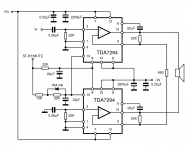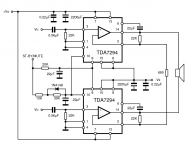Well a full explanation would be beyond this limited medium of expression. I can recommend a book though that I have found immensely useful - see if you can pick up a copy.
Amazon.com: Intuitive IC Op Amps from Basics to Useful Applications (9789997796677): Thomas M. Frederiksen: Books
The short explanation of the bridged circuit is that the top amplifier amplifies by a gain of
1 + [22000/680] and the bottom amplifier takes the output of the first and amplifies it by -1 (inverts basically). It needs the 680R resistor because it needs to think that its still actually amplifying to stop oscillating, the 680R tricks it into thinking just that.
Amazon.com: Intuitive IC Op Amps from Basics to Useful Applications (9789997796677): Thomas M. Frederiksen: Books
The short explanation of the bridged circuit is that the top amplifier amplifies by a gain of
1 + [22000/680] and the bottom amplifier takes the output of the first and amplifies it by -1 (inverts basically). It needs the 680R resistor because it needs to think that its still actually amplifying to stop oscillating, the 680R tricks it into thinking just that.
There is a simple way to connect them as BTL mode. However its not practical because of the input impedance..
So the second (and the robust) way is to use a bridge adaptor like this;
- Make two identical TDA7293 amplifier (refer to TDA7293 datasheet page 1),
- Connect the first amplifiers input to the bridge adaptors +OUT,
- Connect the second amplifiers input to the bridge adaptors -OUT..
- Connect the speakers + pole to the first amplifiers out and -pole to the second amplifiers out.
Thats all.
To make a BPA 200 like amplifier with TDA7293s. Then make two identical modular amplifier (TDA7293 datasheet page 10 figure 7) and use bridge adaptor before them as discripted..
man, can you answer a question on why the R1?
and how can i calculate the value of the rest resists?
thanks.
...
Not at all..
Last edited by a moderator:
There is a simple way to connect them as BTL mode. However its not practical because of the input impedance..
So the second (and the robust) way is to use a bridge adaptor like this;
edit... West Host E.S.P. copyright image removed.
- Make two identical TDA7293 amplifier (refer to TDA7293 datasheet page 1),
- Connect the first amplifiers input to the bridge adaptors +OUT,
- Connect the second amplifiers input to the bridge adaptors -OUT..
- Connect the speakers + pole to the first amplifiers out and -pole to the second amplifiers out.
Thats all.
To make a BPA 200 like amplifier with TDA7293s. Then make two identical modular amplifier (TDA7293 datasheet page 10 figure 7) and use bridge adaptor before them as discripted..
...
Not at all..
Can I use opa1602 for this circuit?
Last edited by a moderator:
so i believe if i use the same components and sister chips, there will be no 'perceivable' problem in the sound. Only problem is i guess the correct value of bootstrap capacitor which will make all the difference in the two circuits.
Should i match the upswing with the downswing using a trim pot in feedback? Or shouldnt i worry about it?
Say we use same supply and similar components, do tda7293 and 94 have any difference at all in the sound?
Should i match the upswing with the downswing using a trim pot in feedback? Or shouldnt i worry about it?
Say we use same supply and similar components, do tda7293 and 94 have any difference at all in the sound?
I've never built an amp with either so can't comment on the sound. The gain should be accurate and depend on the tolerance of the resistors used in the feedback loop. I can't see the bootstap cap making much difference tbh although the way the signal is derived for it appears different in each chip. They are two similar but different amps with different internal circuitry and have to be considered as such. It will all work... its just that you have to accept the compromises, that all.
- Status
- This old topic is closed. If you want to reopen this topic, contact a moderator using the "Report Post" button.
- Home
- Amplifiers
- Chip Amps
- TDA7293 Bridge Parallel Circuit

